![]() 1st Battalion 22nd Infantry
1st Battalion 22nd Infantry ![]()
The 22nd U.S. Infantry Regiment in the Spanish-American War
by Bob Babcock
Part One
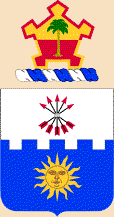
The Coat of Arms of the 22nd Infantry
Regiment.
The crest at the very top is for
the Spanish American War, being the badge of the V Corps in the
Spanish colors,
and charged with a royal palm to commemorate the fact that the
22d Infantry was the first regiment to land on Cuban soil in that
war.
An extract from "Combat Diary - Episodes from the history of the Twenty-Second Regiment, 1866-1905" by A. B. "Bud" Feuer (used with permission of the author) and from "A History of the Twenty-Second United States Infantry" from official records compiled by Captain W. H. Wassell, 22nd Infantry and published in the Philippines in 1904 (from the 22nd Infantry Regiment Society archives).
This compilation and extract from the two books was done in 1998 in honor of the 100th anniversary of the Spanish-American War and expanded and updated on April 6, 2002 in honor of "Task Force Regulars" movement to Cuba. Written by Bob Babcock, veteran of B/1-22 1965-1967 and president of the 22nd Infantry Regiment Society. Deeds not Words!
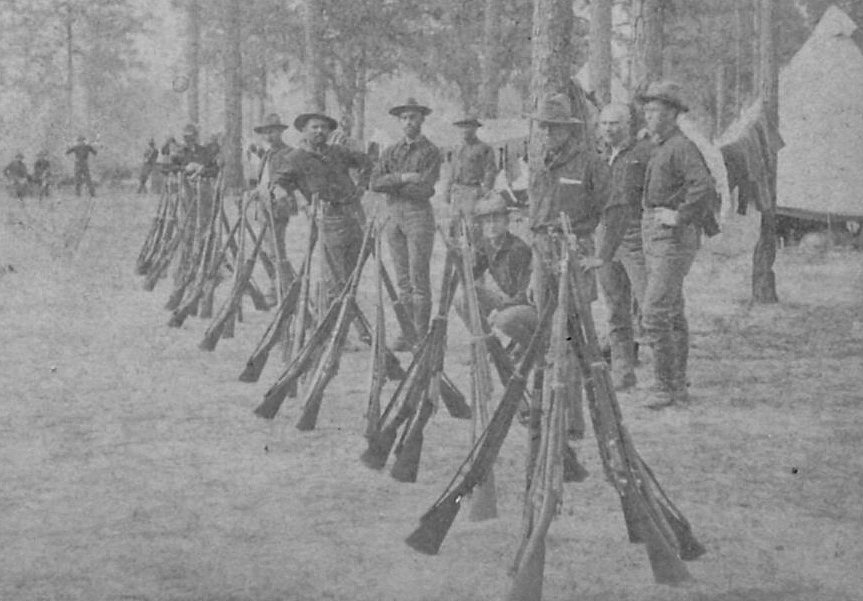
"Camp Scene, 22nd Infantry, Tampa, Florida"
From a stereoview by Underwood & Underwood dated 1898
General:
The 22nd U.S. Infantry fought in Cuba as part of the Fifth Army Corps under the command of Major General William Shafter.
Prelude:
The Spanish-American War is difficult to evaluate. In actual combat, the Indians at Little Big Horn killed almost as many Americans in one afternoon as the Spanish did during the entire conflict.
The real tragedy, however, was that, although the U.S. Army lost approximately 350 men killed in the Cuban campaign against the Spaniards, nearly 2,500 died from disease - malaria, yellow fever, typhoid, and dysentery.
As in all its major wars, the United States found itself woefully unprepared. The entire army consisted of only 28,000 regulars - many of whom would still be needed at frontier posts to keep order in the far west.
It was no secret that there were 200,000 Spanish soldiers stationed throughout Cuba - but their exact disposition was unknown - and there were no accurate maps of the country or its harbors.
Like all regular army units of this period, the 22nd Infantry Regiment had been brought up to a high state of efficiency and readiness. Most of the troops had had several years of service. They were a fearless breed of men, accustomed to being vastly outnumbered, and could be depended upon to fight to the last man.
After the USS Maine disaster, as the nation drew nearer to the outbreak of hostilities with Spain, the 22nd Infantry Regiment quietly made preparations for war.
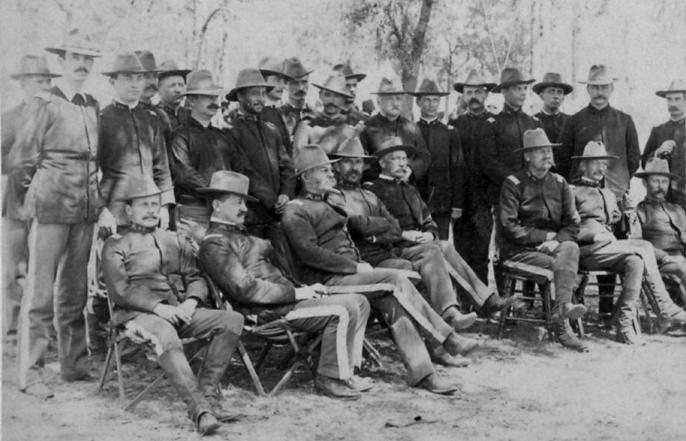
Col Wikoff and officers of the 22nd Infantry, Tampa 1898
Colonel Wikoff is seated, front row, fifth from the left
From a stereoview by Underwood & Underwood dated 1898
Movement toward Cuba:
On April 18, 1898, the Regiment, under the command of Colonel Charles A. Wikoff, departed Fort Crook, NB by rail, enroute to Mobile, AL. Twenty-nine officers and 484 enlisted men constituted the organization.
At every stop, the troop train carrying the 22nd Infantry Regiment was greeted by enthusiastic citizens and brass bands. As the train lumbered south, decorative flowers were attached to the railroad cars. Colonel Wikoff and his frontier soldiers arrived at the Alabama port on April 20 - war was officially declared on April 25, 1898.
On April 28, 1898 the 22nd Infantry Regiment received orders to break camp. They boarded a train for Tampa, FL and arrived on May 2. For the next few weeks, the monotonous and tedious days would be spent in drilling by company, battalion, and Regiment.
While at Tampa, the 22nd Infantry Regiment was assigned to the First Brigade, Second Division, Fifth Army Corps. The First Brigade was comprised of the 22nd and 8th Infantry Regiments (thus continuing a close relationship between the two regiments which started in the Indian Wars and continued in World War II, the Cold War, Vietnam, and elements are still part of the 4th Infantry Division today), and was commanded by General William Ludlow. Major General William R. Shafter was the Fifth Corps commander.
General Shafter's corps was composed of 15,337 men - including nineteen infantry regiments, four light artillery batteries, two siege batteries, two companies of engineers, one detachment of signal corps, forty-eight troops of cavalry (dismounted), and a single hospital unit. The Fifth Army Corps was almost entirely composed of regulars, with the exception of three regiments, including Teddy Roosevelt's Rough Riders. (Personal note - my grandfather, Bert Morgan Babcock, fought as an infantryman with the 20th Infantry Regiment as part of this corps).
When Nelson Miles, commanding general of the army, arrived in Tampa on June 1, he was appalled at what he saw. Miles immediately realized that the army was not ready for a campaign in the tropics - the troops from the northern posts were still wearing their winter uniforms. Because of delays in the army's supply department, summer clothing had never been shipped. The 22nd Infantry was one of the units that was forced to wear their heavy uniforms thoughout the Cuban action.
On the morning of June 7, 1898, the 22nd Infantry Regiment broke camp and marched aboard the USS Orizaba. After a delay of seven days, the troops sailed for Santiago. Aboard the Orizaba, the men of the 22nd Infantry packed the railings to watch the unforgettable spectacle. Lieutenant Kreps noted: "The scene presented by the embarkation was a memorable one -and was witnessed from the wharves by thousands of people who had been arriving at the port during the past twenty-four hours. . . . Bright signal flags and bunting whipped from every mast. And that, along with the cheering and patriotic music, lifted the spirits of the weary soldiers. The waiting was over - we were off to war at last!"
|
The 22nd
Infantry Regiment From a stereoview by |
Landing of the Regiment in Cuba:
The expedition arrived off the Morro Castle entrance to Santiago Bay about noon on June 20. At that time, Colonel Wikoff was transferred to the Third Brigade, and Lieutenant Colonel John H. Patterson was placed in command of the 22nd Infantry Regiment.
Captain Wassell wrote: "Daiquiri, seventeen miles east of Santiago, was the site chosen for the 22nd Infantry to disembark. There was an iron pier, five hundred feet long, and also a wharf.....The Regiment climbed into the boats and headed through the rough seas toward the smoldering dock. Enthusiasm ran high and rousing cheers burst from the transports still waiting to be unloaded. Regimental bands played -while out at sea, the navy bombarded the wooded mountains that rose above from the beach. Shells whistled over our heads and exploded far up on the heights......Near the dock, a wall of surf roared an angry welcome - then broke in swamping torrents. Boats smacked against boats, and crashed against the pier - then, thrown back by outgoing waves, they were flung forward again - someone finally grabbing a line tossed from the beach. The troops scrambled out, tossing blanket rolls ahead of them - but carefully handing rifles to helping comrades. Surf drenched and panting, the men of the 22nd Infantry caught their breath - then cheered as the Regimental colors were unfurled." The 22nd Infantry Regiment was the first American Regiment to land in Cuba. (The royal palm on our Regimental colors forever commemorates that deed).
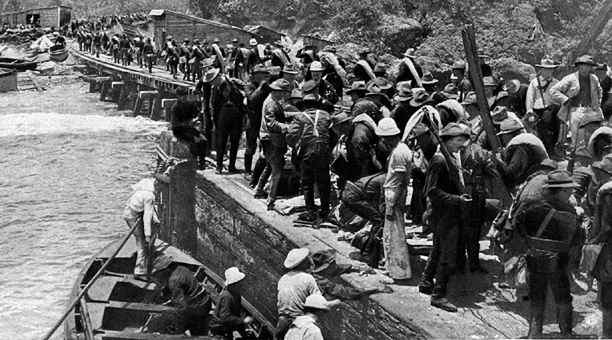
U.S. troops come ashore at Daiquiri
After a brief rest, the 22nd Infantry marched about four miles in the direction of Siboney and then camped near Daiquiri Creek. Captain Carroll Dunham, division medical officer, described the march inland: "When the troops landed on the beach at Daiquiri, each man carried a blanket, poncho, and three days' rations rolled up in half of a shelter tent. However, as they trudged along the hilly trail, the choking dust turned to mud on their sopping wet uniforms. The ferocious sun bore down on the uncomfortable men and many threw away their blankets. It was not long before clothing and haversacks began to litter the path. The scene looked more like a retreat than an unopposed advance.....Many of the men had abandoned their rations - and as there was no hope of a supply train reaching the camp before two or three days, the situation threatened to become serious."
The following morning, June 23, the 22nd Infantry Regiment headed the advance inland and by noon had taken possession of Siboney, the Spanish force of six hundred retiring and offering no resistance. After entering the town, men from Company B (Crittenden’s) captured on the mountains to the east the first Spanish colors taken in the campaign. (These colors are now in Cullom Hall at West Point). For the next several days, the 22nd fought the heat and the elements. On the morning of June 27, 1898, General Ludlow moved the 22nd Infantry forward about four miles on the El Caney road. The Regiment remained there until the afternoon of June 30, when General Lawton ordered the entire division to resume its march north.
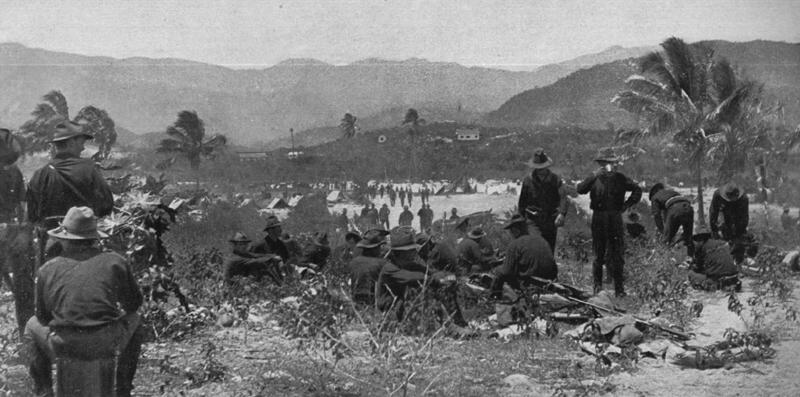
The encampment at Daiquiri Creek

Streamer for Spanish-American War Campaign awarded to 22nd Infantry
Home | Photos | Battles & History | Current |
Rosters & Reports | Medal of Honor | Killed
in Action |
Personnel Locator | Commanders | Station
List | Campaigns |
Honors | Insignia & Memorabilia | 4-42
Artillery | Taps |
What's New | Editorial | Links |